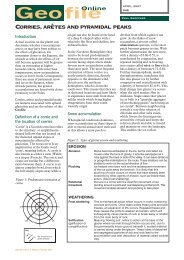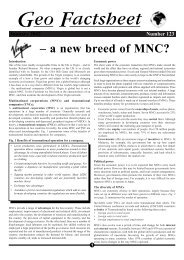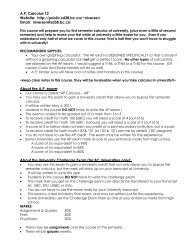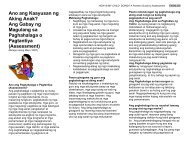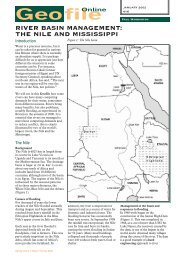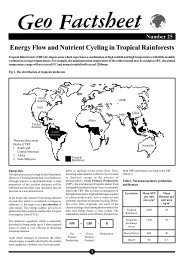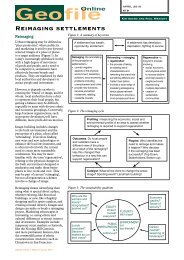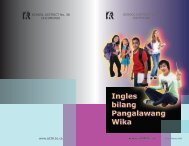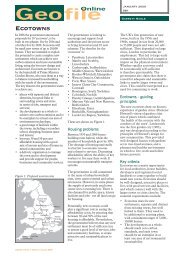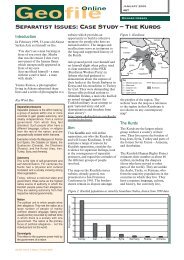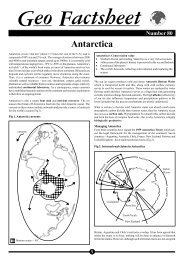Energy and Transport.pdf - Richmond School District No. 38
Energy and Transport.pdf - Richmond School District No. 38
Energy and Transport.pdf - Richmond School District No. 38
- No tags were found...
Create successful ePaper yourself
Turn your PDF publications into a flip-book with our unique Google optimized e-Paper software.
Seriescardiovascular risk. 36 Aviation produces noise <strong>and</strong> airpollution. Night flights have the greatest effect on localresidents <strong>and</strong> there are high concentrations of nitrogenoxides around airports, although most is from associatedcar traffic rather than directly from aviation. 33Shipping emissions contribute an estimated 10–20% tothe overall concentration of particles measuring 10 μm orless for most coastal areas in western Europe. 33 Emissionsfrom international trading ships in the seas aroundEurope were estimated at 2·6 million tonnes of sulphuroxides <strong>and</strong> 3·6 million tonnes of nitrogen oxides a yearin 2000. The main ports of southern California, USA, areresponsible for daily emissions of about 116 tonnes ofnitrogen oxides, compared with about 92 tonnes fromthe 6 million cars in the region. 37Access <strong>and</strong> community severanceAchieving high levels of accessibility to shops, markets,employment, education, health services, <strong>and</strong> social <strong>and</strong>community networks is essential for health, quality oflife, <strong>and</strong> social inclusion. However, transport policy oftenfocuses on mobility rather than access. The 2006 EUmid-term review of transport strategy states that mobilityis the quintessential purpose of transport policy. <strong>38</strong>Increasing use of cars improves access for thoseindividuals who are newly motorised but reduces accessfor others through danger <strong>and</strong> congestion. Danger fromhigh volumes of traffic can make reaching even nearbydestinations difficult, which can reduce access to services,employment, <strong>and</strong> social support networks. These effectsare known as community severance, <strong>and</strong> can affect healthin several ways. Particularly hard hit are people who areelderly or disabled, parents or carers pushing prams, <strong>and</strong>children. 39,40 In the longer term, urban sprawl can reducesocial capital <strong>and</strong> increase social segregation. 41,42 Ecologicalstudies show worse self-reported health in people livingin sprawled cities. 43Harms are created through too much mobility <strong>and</strong> toolittle access. A Dutch study, including freight <strong>and</strong>passenger transport, found that strategies to achievesubstantial reductions in emission would reduceinequalities in the costs <strong>and</strong> benefits of transport, travelbehaviour, <strong>and</strong> accessibility of economic <strong>and</strong> socialopportunities. 44Disability <strong>and</strong> impairment<strong>Transport</strong> is a direct cause of impairments, throughroad-traffic injuries, <strong>and</strong> an indirect determinant, throughphysical inactivity. Obesity can be considered animpairment. Moreover, transport affects the quality oflife of people with impairments by the creation ofenabling or disabling environments. Traffic dangerincreases the requirements for social participationthrough the need to judge speeds, see over traffic, <strong>and</strong>cross roads quickly. The social model of disability viewscertain environments as creating disabilities in peoplewith impairments. Applying the social model ofdisabilities to transport can help us underst<strong>and</strong> howcar-dominated transport systems create disabilitiesbeyond those conventionally categorised as having adisability. 45 Training, tricycles, h<strong>and</strong> cycles, <strong>and</strong> t<strong>and</strong>emscan increase the take-up of active transport among peoplewith impairments. Small electric scooters with speedssimilar to pedestrians or cyclists are a less active but stilllow energy alternative.Other effectsEnvironment <strong>and</strong> economyInvestment in motorised road transport is directly <strong>and</strong>indirectly resource-intensive. This use of resources isclosely related to energy use, <strong>and</strong> raises questions ofenvironmental sustainability beyond climate change.Furthermore, such transport imposes considerableexternal indirect costs on society. However, transportsupports millions of jobs <strong>and</strong> businesses worldwide <strong>and</strong>is widely seen as having a special role in economicdevelopment.<strong>Transport</strong> resource use can be considered as having ahealth-related opportunity cost. That cost is the lostopportunity to use these resources in ways with a morebenign health profile. Although usually st<strong>and</strong>ardised inmonetary units, the cost can be thought of as specificscarce resources. The opportunity cost can be measuredfrom an individual or societal perspective. Lower-incomegroups spend a higher proportion of their income ontransport than do richer populations. Expenditure ontransport is not then available for health care, food, oreducation. 46 There is little analysis of the health effects ofthese costs.From a lifecycle <strong>and</strong> systems perspective, transportresource includes vehicle production, use, <strong>and</strong> disposal,together with dependent industries such as construction,oil, steel, rubber, insurance, advertising, <strong>and</strong> finance. 47,48Car production uses nearly half the world’s annual outputof rubber, 25% of its glass, <strong>and</strong> 15% of its steel. 49 Mostmotor vehicles are privately owned but road networks areusually led <strong>and</strong> financed by the state, with high costs.The widening of the M1 motorway in the UK is predictedto cost £5·1 billion, around £21 million a mile. Investmentin transport infrastructure mainly benefits those who canafford to take advantage of it. Decisions on transportinfrastructure determine the transport options availableto individuals <strong>and</strong> firms, <strong>and</strong> can act as a substantialsubsidy.The energy use of cars is closely related to their l<strong>and</strong>requirements. These requirements limit l<strong>and</strong> availabilityfor other uses, including agriculture. Estimates suggestthat increased transport infrastructure in China willoccupy an additional 270 000 km² between 2004 <strong>and</strong> 2020,dispossessing 3·7 million farmers. 5Although car <strong>and</strong> truck use bring substantial economicbenefits, the harms impose costs on society not in themain borne by the vehicle user or business. This marketfailure acts to both encourage further use <strong>and</strong> discouragewww.thelancet.com Published online September 13, 2007 DOI:10.1016/S0140-6736(07)61254-9 5



